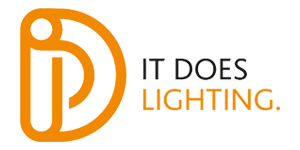We don’t just believe light improves health – we can prove it!
Learning and exploring the fascinating world of light has become a way of life for Lorraine Calcott, Principal of it does Lighting Ltd. Lorraine has always strived to increase her knowledge about her chosen field of expertise and each year endeavours to so that she can deliver thought leading information and cutting edge design to her customers.
As LED lighting has evolved over the last 10 years it’s now possible to achieve artificial light that closely mimics natural daylight. This is done by utilising changes in intensity and colour temperature to follow – as closely as possible – the dynamic nature of natural sunlight through the course of a day. Full spectrum circadian LED lighting gets very close to achieving what nature has been doing for years, but how close is close?
After exploring the research of others Lorraine decided that she wanted to delve even deeper into the subject of how light effects our circadian rhythms – or body clock – and its potential health benefits. So to do this she has embarked on a PhD. with Cranfield University where she is researching the potential health benefits of improved sleep on those suffering with Dementia and Alzheimer’s.
The aim of the research is to explore how delivering biophilic light helps regulate the body’s cells to improve sleep and therefore reduce symptoms of these crippling conditions. The benefits of improved sleep can also help many other areas of health which include helping those with fertility issues, mental health concerns, insomnia, jet lag, infant sleep patterns, autism, shift workers, aging and even improving learning capability.
Even those who have lost their sight can be helped as although they can no longer distinguish light from dark the ganglion cells (which are non-visual) will still be working and can therefore keep time for the body’s functions by being exposed to light at the right time of day.
The blue end of the visible light spectrum provides the most measurable changes in our body clock, as it tells the body to be alert. However, all wavelengths of visible light can affect our circadian rhythm so exposure should be regulated where light intensity is also high. Being aware of how light affects our cells and what benefit or detriment it can make is a key part of Lorraine’s research. Information for those exposed to artificial light remains a priority. This is so we can all take responsibility for improving our health and well-being when it comes to synchronising our body clocks to maintain their natural state and improve our sleep.
Take a look at our animation which was produced as part of stage one of the research. It gives a brief overview of how lack of sleep might affect health and indicates the right kind of artificial lighting could help improve it.
If you would like further information on this subject, please get in touch. We wish to work with those looking to improve sleep or general health and will share our research as we progress. So if you are looking to sleep better call now 01908 560110.

“The blue end of the visible light spectrum provides the most measurable changes in our body clock, as it tells the body to be alert.”
Light is a potent stimulus for regulating circadian, hormonal, and behavioral systems. In addition, light therapy is effective for certain affective disorders, sleep problems, and circadian rhythm disruption. These biological and behavioral effects of light are influenced by a distinct photoreceptor in the eye, melanopsin containing intrinsically photosensitive retinal ganglion cells (ipRGCs), in addition to conventional rods and cones. We summarize the neurophysiology of this newly described sensory pathway and consider implications for the measurement, production, and application of light. A new light-measurement strategy taking account of the complex photoreceptive inputs to these non-visual responses is proposed for use by researchers, and simple suggestions for artificial/ architectural lighting are provided for regulatory authorities, lighting manufacturers, designers, and engineers.
For decades, both the installation and operating costs associated with electric lighting systems has been considered an ongoing monetary expense when it comes to ROI. Accounting for up to 22%1 of yearly business expense, rising energy costs are driving the growing acceptance of modern building science solutions which employ electronic lighting sources and daylighting technologies for the purpose of reducing ongoing operating costs. However the shift towards energy efficient lighting practices can only be thought of as a first step towards reducing ongoing business related costs. A lighting strategy which has the potential to reduce healthcare premiums and related healthcare burden will be a paradigm shift with direct financial benefit. In 2011, the Kaiser Family Foundation report calculated the average business contribution for family health care premiums alone to be $10,944.00 per employee per year. Recognized as Circadian Adaptive Lighting this new lighting strategy has the potential for creating a health promoting built environment while fostering lean bottom line yearly expense. In the coming years ahead, the effectiveness of this strategy will be evident in three areas: a.) measurable enhanced sleep efficiencies, now recognized as instrumental in health promotion, preventing disease and major contributor in the healing process, b.) measurable lower allostatic load index scores, a biomarker and non- invasive health assessment used to determine physiological dysregulation in the workplace now also recognized as an indicator of disease trajectories2, 3.) and for business owners, an overall reduction of expense line items including: employer health care premiums, costs associated with medical and employee errors, and the escalating costs associated with workplace accidents and fatalities especially among shift work populations. A lighting strategy which is supportive of the human need for both ambient light and darkness levels suitably designed to impact the human circadian system will be the way forward in transferring lighting costs from a line item expense to a valued investment asset.
- Human Centric Lighting is the inclusion of visual and non-visual (biological) needs of humans in the design of lighting applications.
- Our project aimed at delivering arguments for the use of human centric lighting from a customer perspective and simulated segment-specific economic benefits on micro and macro level.
- On the micro level (perspective of individual investors, e.g. facility owners):
- Most significant quantified benefits are realized in industrial segments due to the dominant impact of productivity increases
- Medical and elderly care segments show less attractive quantified benefits, as most savings cannot be realized by the investor, but by other stakeholders, e.g. insurance companies
- On the macro level (perspective of the general public, e.g. health insurances):
- Macro level simulations yield Human Centric Lighting effects for Europe in 2020 of up to € 0.87 bn assuming a realistic market penetration1 and € 12.8 bn if the 2020 lighting market was fully penetrated by Human Centric Lighting
- In most segments, benefits for owners and investors dominate
- However, additional social and public benefits can also justify Human Centric Lighting markups
Sleep disorders are problematic for persons with dementia and their family caregivers. This randomized controlled trial with crossover evaluated the effects of an innovative blue-white light therapy on 17 pairs of home-dwelling persons with dementia and their caregivers. Subjects with dementia received blue-white light and control (‘red-yellow’ light) for six weeks separated by a four-week washout. Neither actigraphic nor most self-reported sleep measures significantly differed for subjects with dementia. For caregivers, both sleep and role strain improved. No evidence of retinal light toxicity was observed. Six weeks of modest doses of blue- white light appear to improve sleep in caregivers but not in persons with dementia. Greater or prolonged circadian stimulation may be needed to determine if light is an effective treatment for persons with dementia.
Sleep disturbances are common in persons with Alzheimer’s disease or related dementia (ADRD), resulting in a negative impact on the daytime function of the affected person and on the wellbeing of caregivers. The sleep/wake pattern is directly driven by the timing signals generated by a circadian pacemaker, which may or may not be perfectly functioning in those with ADRD. A 24-hour light/dark pattern incident on the retina is the most efficacious stimulus for entraining the circadian system to the solar day. In fact, a carefully orchestrated light/dark pattern has been shown in several controlled studies of older populations, with and without ADRD, to be a powerful non-pharmacological tool to improve sleep efficiency and consolidation. Discussed here are research results from studies looking at the effectiveness of light therapy in improving sleep, depression, and agitation in older adults with ADRD. A 24-hour lighting scheme to increase circadian entrainment, improve visibility, and reduce the risk of falls in those with ADRD is proposed, and future research needs are discussed.
Critically ill patients frequently experience poor sleep, charactersized by frequent disruptions, loss of circadian rhytems, and a paucity of times spent in restorative sleep stages. Factors that are associated with sleep disruption in the intensive are unit (ICU) include patient-ventilator dysynchrony, medications, patient care interactions, and environmental noise and light. As the field of critical care increasingly focuses on patients’ physical and psychological outcomes following critical illness, understanding the potential contribution of ICU-related sleep disruptions on patient recovery is an important area of investigation. This review article summarizes the literature regarding sleep a architecture and measurement in the critically ill, causes of ICU sleep fragmentation, and potential implications of ICU-related sleep disruption on patient’s recovery from critical illness. With this background information, strategies to optimize sleep in the ICU are also discussed,
For the greater part of 150 years it was assumed that the mammalian retina contained only two types of photoreceptors; rods and cones. However, a flurry of recent evidence has demonstrated the existence of a third type of mammalian photoreceptor that differs greatly from rods and cones. This type utilizes a different photopigment, is much less sensitive to light, and has far less spatical resolution; characteristics that fit perfectly with this photoreceptor’s primary function if signaling changes in ambient light levels to the brain throughout the day. Most surprisingly, these photoreceptors are ganglion cells, and thus, have the uniwue ability to communicate directly with the brain. These intrinsically photosensitive retinal ganglion cells (ipRGCs) are a rate sub-population of ganglion cells (1-3%) whose primary role is to signal light for unconscious visual reflexes, such as pupillary constriction, and regulating a number of daily behavioral and physiological rhythms, collectively called circadian rhythms. This latter process, which adjusts circadian rhythms to the light/dark cycle of an animal’s environment, is known as photoentrainment. The visual behaviors under ipRGC control are remarkably tonic, and require long integration times of ambient light levels. The unique properties of ipRGCs, both functionally and anatomically, make them well suited for regulating such behaviors.
Although we still lack any consensus function(s) for sleep, accumulating evidence suggests it plays an important role in homeostatic restoration, thermoregulation, tissue repair, immune control and memory processing. In the last decade an increasing number of reports continue to support a bidirectional and symbiotic relationship between sleep and memory. Studies using procedural and declarative learning tasks have demonstrated the need for sleep after learning in the offline consolidation of new memories. Furthermore, these consolidation benefits appear to be mediated by an overnight neural reorganization of memory that may result in a more efficient storage of information, affording improved next-day recall. Sleep before learning also appears to be critical for brain functioning. Specifically, one night of sleep deprivation markedly impairs hippocampal function, imposing a deficit in the ability to commit new experiences to memory. Taken together, these observations are of particular ecologic importance from a professional and education perspective when considering that sleep time continues to decrease across all age ranges throughout industrialized nations.
Melatonin synthesis from the pineal gland is regulated by the circadian pacemaker located in the suprachiasmatic nuclei and by ocular light exposure. Melatonin has a circadian rhythm that peaks during the night in normally entrained indi- viduals. In the absence of light and other synchronizing signals, the rhythm of melatonin production persists with an elevation that occurs during the subjective, as opposed to the actual, night. There is a relatively direct anatomic pathway between the suprachiasmatic nuclei and the pineal gland, and comparatively few exogenous factors are known to affect melatonin concen- trations (see Table 1 from Arendt, 2005, for a summary of these factors).1 As a result, the rhythm of melatonin production has been shown to re ect both the phase and, if collected over more than 1 cycle, the period of the endogenous circadian oscillator, thus providing a reliable means to estimate the timing of the internal circadian clock located in the suprachiasmatic nuclei.
Evolution has shaped us to live in much more light than our modern indoor life gives us. We generally need most light in the morning and during the day, less in the evening, and the least possible at night. Ideally, this implies getting outside as much as possible during daytime, along with improved (24-hour) control of indoor lighting systems, so that we sleep better and wake up refreshed.
Light affects human beings in a variety of ways – visually, (photo-)biologically and psychologically. In healthcare facilities it can play a key role in promoting the recovery and well-being of patients.There is a clear correlation between daytime light exposure and the patient’s perceived quality of life.The more time spent in daylight, or in daylight-like artificial light, the better the patient’s visual performance and comfort, mood, sleep-wake rhythm, concentration, alertness and performance. Clinical parameters such as recovery/length of stay, depression, pain medication and cognitive decline are likewise positively influenced by adequate daytime light exposure.There is also strong evidence that light – critical to human functioning – can be extremely beneficial to staff in healthcare settings as well as patients.
Abstract – Although we still lack any consensus function(s) for sleep, accumulating evidence suggests it plays an important role in homeostatic restoration, thermoregulation, tissue repair, immune control and memory processing. In the last decade an increasing number of reports continue to support a bidirectional and symbiotic relationship between sleep and memory. Studies using procedural and declarative learning tasks have demonstrated the need for sleep after learning in the offline consolidation of new memories. Furthermore, these consolidation benefits appear to be mediated by an overnight neural reorganization of memory that may result in a more efficient storage of information, affording improved next-day recall. Sleep before learning also appears to be critical for brain functioning. Specifically, one night of sleep deprivation markedly impairs hippocampal function, imposing a deficit in the ability to commit new experiences to memory. Taken together, these observations are of particular ecologic importance from a professional and education perspective when considering that sleep time continues to decrease across all age ranges throughout industrialized nations. ?? 2008 Elsevier B.V. All rights reserved.
Abstract – Reduced sleep duration and quality appear to be endemic in modern society. Curtailment of the bedtime period to minimum tolerability is thought to be efficient and harmless by many. It has been known for several decades that sleep is a major modulator of hormonal release, glucose regulation and cardiovascular function. In particular, slow wave sleep (SWS), thought to be the most restorative sleep stage, is associated with decreased heart rate, blood pressure, sympathetic nervous activity and cerebral glucose utilization, compared with wakefulness. During SWS, the anabolic growth hormone is released while the stress hormone cortisol is inhibited. In recent years, laboratory and epidemiologic evidence have converged to indicate that sleep loss may be a novel risk factor for obesity and type 2 diabetes. The increased risk of obesity is possibly linked to the effect of sleep loss on hormones that play a major role in the central control of appetite and energy expenditure, such as leptin and ghrelin. Reduced leptin and increased ghrelin levels correlate with increases in subjective hunger when individuals are sleep restricted rather than well rested. Given the evidence, sleep curtailment appears to be an important, yet modifiable, risk factor for the metabolic syndrome, diabetes and obesity. The marked decrease in average sleep duration in the last 50 years coinciding with the increased prevalence of obesity, together with the observed adverse effects of recurrent partial sleep deprivation on metabolism and hormonal processes, may have important implications for public health.
Abstract – Breast cancer is the leading cause of cancer death among women worldwide, and there is only a limited explanation of why. Risk is highest in the most industrialized countries but also is rising rapidly in the developing world. Known risk factors account for only a portion of the incidence in the high-risk populations, and there has been considerable speculation and many false leads on other possibly major determinants of risk, such as dietary fat. A hallmark of industrialization is the increasing use of electricity to light the night, both within the home and without. It has only recently become clear that this evolutionarily new and, thereby, unnatural exposure can disrupt human circadian rhythmicity, of which three salient features are melatonin production, sleep, and the circadian clock. A convergence of research in cells, rodents, and humans suggests that the health consequences of circadian disruption may be substantial. An innovative experimental model has shown that light at night markedly increases the growth of human breast cancer xenografts in rats. In humans, the theory that light exposure at night increases breast cancer risk leads to specific predictions that are being tested epidemiologically: evidence has accumulated on risk in shift workers, risk in blind women, and the impact of sleep duration on risk. If electric light at night does explain a portion of the breast cancer burden, then there are practical interventions that can be implemented, including more selective use of light and the adoption of recent advances in lighting technology and application. CA Cancer J Clin 2014;64:207-218. © 2013
Abstract – Daylight has been associated with multiple health advantages. Some of these claims are associations, hypotheses or beliefs. This review presents an overview of a scientific literature search on the proven effects of daylight exposure on human health. Studies were identified with a search strategy across two main databases. Additionally, a search was performed based on specific health effects. The results are diverse and either physiological or psychological. A rather limited statistically significant and well-documented scientific proof for the association between daylight and its potential health consequences was found. However, the search based on specific health terms made it possible to create a first subdivision of associations with daylight, leading to the first practical implementations for building design.
Our research partners



Passionate About Lighting Design
Call us on +44 (0)1908 560110 so we can get your project started or contact us by clicking on the button below


